This article was last updated on April 2, 2025, to reflect the latest developments in service dog air travel.
Boarding a flight with your service dog is easy when you have the paperwork filled out correctly, and this guide walks you through the DOT service animal form step-by-step so you can enjoy a hassle-free flight. But please note the rules for emotional support dogs have changed.
In 2021, the U.S. Department of Transportation updated its rules for assistance animals on flights. The new rules essentially banned emotional support animals from flights but still allow service dogs and psychiatric service dogs to board, as long as their owners use the DOT form.
If you plan to fly with a service dog, you’ll need to submit the DOT’s Service Animal Air Transportation Form to your airline before boarding. Passengers who can complete this form can board the cabin with their assistance dogs free of charge, be exempt from size and weight limitations applicable to pets, and have their dog sit on the floor or their lap if they are small enough.
The DOT Form can seem intimidating at first, but it should be easy for most service dog owners to complete once they’re familiar with it. In this article, we will provide a clear guide and helpful tips on how to complete and use the DOT Form for traveling with your service dog or psychiatric service dog.
How to Fill Out the DOT’s Service Animal Air Transportation Form
- Share Basic Details
- Confirm Animal Health
- Confirm Disability Status
- Verify Animal Training
- Attest to Animal Behavior
- Acknowledge Other Assurances
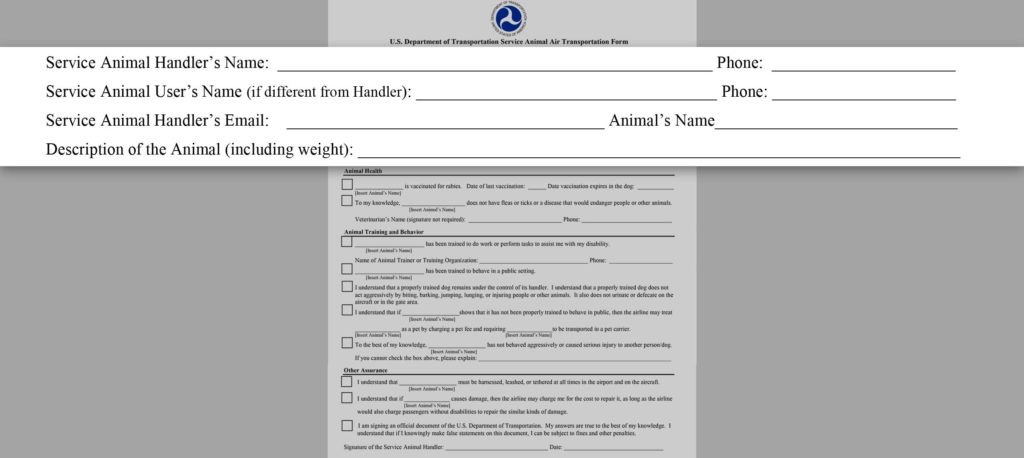
1. Basic Information
The first section of the DOT Form asks for basic information regarding the owner of the service dog and the service dog itself. For most people, the name of the handler and “user” will be the same person.
However, there may be instances where the handler and user may be different, so two names are required. For example, a helper may be transporting a service dog on a flight to its owner.
In this section of the Form, you will also need to provide a written description of your service dog (including its weight) and name. A photo of your service dog is not necessary, and you do not need to carry around any type of ID card for your dog when you travel.
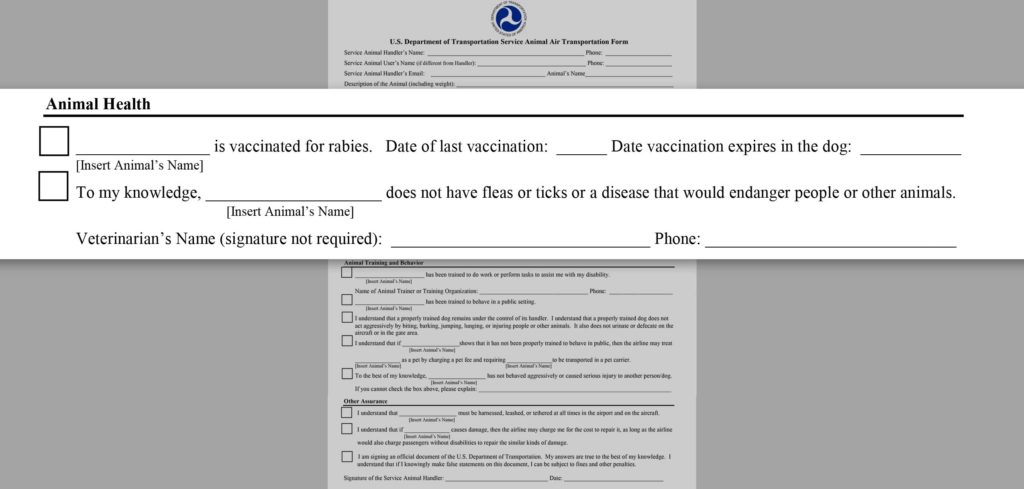
2. Confirm Animal Health
The animal health section of the Form requires you to confirm that your service dog has been vaccinated for rabies. You must provide the date of the last vaccination, and the vaccination must be current. You also have to verify that your service dog does not have fleas, ticks, or a disease that would endanger other people or animals.
The last part of this section requires the name of your service dog’s veterinarian and their telephone number. The veterinarian does not need to sign the form.

3. Confirm Disability Status
To even be eligible to use the DOT Form, you must have a disability. The term “disability” has a specific meaning under the DOT’s rules. A disability eligible for a service dog can be physical or mental/emotional in nature. Whatever the health condition may be, it must substantially limit one or more major life activities.
- Physical disabilities are conditions like visual impairment or mobility issues.
- Psychiatric disabilities include conditions like severe depression, anxiety, PTSD, bipolar disorder, or phobia. A licensed mental health professional can evaluate whether you meet the criteria for mental health disability under ACAA rules and give you a PSD letter.
It’s important to be truthful about everything you add to this form. The DOT Form is a federal form, and there are potential penalties and consequences for knowingly making misrepresentations.
How to Get Your Psychiatric Service Dog Letter from ESA Doctors

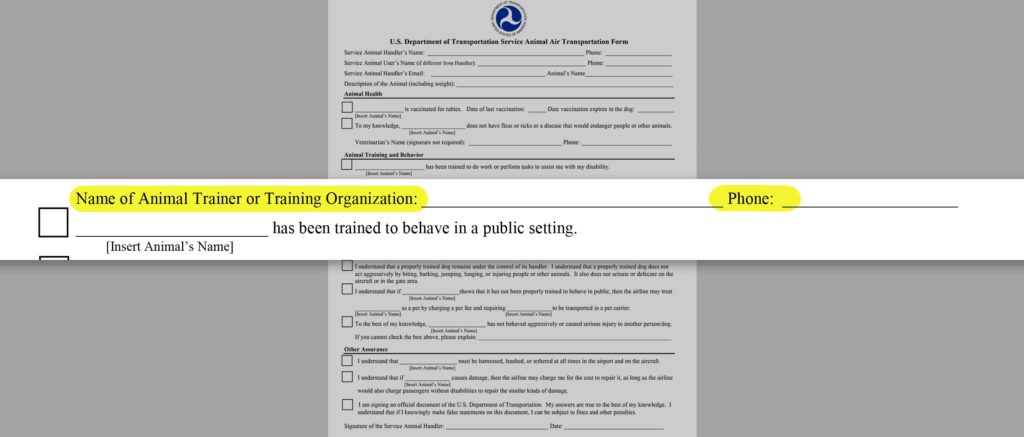
4. Verify Service Dog Training
To be considered a service dog, the dog must be fully trained to perform a task or work related to the owner’s disability. The DOT Form asks for the name of the animal’s trainer, but it is completely fine to list yourself if you trained your dog. This has caused some confusion among service dog owners, as many service dog owners undertake training themselves without using a trainer. If you were responsible for training your dog, you would put your name as the trainer along with your phone number.
The DOT’s regulations made clear that you do not need a third-party trainer or organization to train your dog or certify that they have been fully trained. The DOT specifically rejected any requirement that service dogs be trained or evaluated by any organization in creating the Form. The DOT believed this would create an undue burden on service dog owners, many of whom are capable of training their animals without outside help.
Service dog owners also do not need any certification of the training from any organization. A common misconception is that service dogs need to be “certified” in order to be official – that is not untrue. You alone are responsible for confirming that your dog is fully trained.
Service dogs that help with physical disabilities perform countless tasks, such as guiding visually or hearing impaired people, pulling wheelchairs, and providing diabetic alerts when there are changes in the owner’s blood sugar.
Psychiatric service dogs perform numerous tasks. They include things like providing comfort during moments of anxiety or panic with pawing, pressure, or licking, reminding handlers to take medication, interrupting psychotic episodes or dissociative events, or providing a buffer against crowds or other triggering threats.
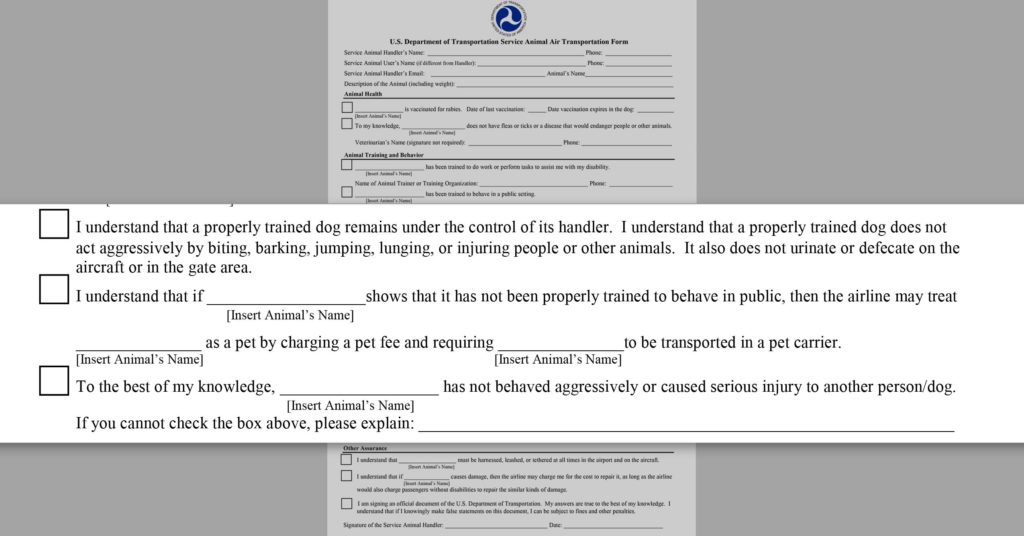
5. Attest to Animal Behavior
In addition to attesting your service dog has been task-trained, you must confirm it has been trained to behave in public. In public areas, your service dog should be under your control at all times and not exhibit disruptive or aggressive behavior like biting, barking, jumping, or lunging at others.
Your service dog should also not relieve itself during the flight or in the gate area (except on flights longer than 8 hours; see below). You must also attest that, to your knowledge, your service dog has not behaved aggressively or caused serious injury to another person or animal.
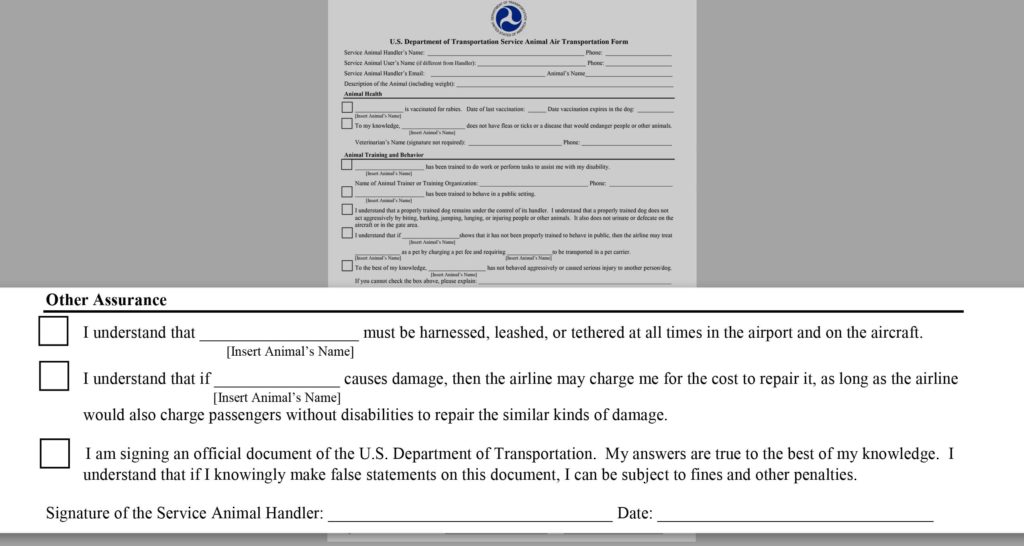
6. Acknowledge Other Assurances
The final section of the DOT Form requires you to recognize that your service animal must be harnessed, leashed, or tethered at all times while at the airport and during the flight.
You must also acknowledge that if your service dog causes any damage, the airline can charge you for any repairs. Finally, you must acknowledge that you are signing an official DOT document. That means if you knowingly make false statements, you can be subject to fines and other penalties, making it important to be truthful and accurate about your health condition and service dog’s abilities.
Example of Completed Form
For illustrative purposes, below is an example of a form completed by a person who has self-trained their service dog:
For Flights Longer than 8 Hours
If you are boarding a flight that will last longer than 8 hours, you’ll need an additional form called the Department of Transportation’s Service Animal Relief Attestation Form (Relief Form).
The Relief Form is fairly straightforward to complete. It requires you to select one of two options:
- Your service dog will not relieve itself while on the aircraft; OR
- Your service dog can relieve itself during the flight without creating a health or sanitation issue.
If you select the second option, you also have to describe how your service dog will relieve itself without creating a health and sanitation issue (for example, using a dog diaper). The Relief Form also requires you to acknowledge that you may be charged by the airline for damage caused by your service dog.
How to Submit the DOT Forms
Most airlines have an option during booking to notify them that you will be traveling with a service dog. After booking a flight, you will submit the form either through an online link or to an email address.
The form should be submitted at least 48 hours before your flight. If you book a flight taking off within 48 hours, you can usually provide the form in person at the gate when checking in.
For airline-specific guides to flying with a service dog or psychiatric service dog, visit the following pages:
- Alaska Airlines
- Allegiant Air
- American Airlines
- Air Canada
- Delta Air Lines
- Frontier Airlines
- Hawaiian Airlines
- Jet Blue
- Southwest Airlines
- Spirit Airlines
- United Airlines
Recent Troubles
Recently, complaints have been rising among service dog owners attempting to fly with their dogs. Airlines appear to be rejecting submissions of the DOT Form for inconsistent reasons. One news source reported that the new DOT requirements have made flying so difficult that it is making visually impaired service dog owners think twice about flying. Advocacy organizations for the blind are calling for the DOT form to be changed or eliminated.
Statistics from the DOT are consistent with these complaints, showing that service-animal-related complaints from handlers have more than doubled since the new form requirements were instituted.
The executive director of the Harvard Law School Project on Disability also criticized the form, saying there was no clear rationale behind it, as they do not help airline staff separate fake service dogs from real ones.
Certain airlines like JetBlue, Allegiant Airlines, Sun Country Airlines, and Alaska Airlines have outsourced the processing of DOT forms to a third-party organization. Travelers have reported issues with having their forms rejected by these airlines for claimed errors.
The takeaway for service dog owners is that while the new DOT regulations have certainly made air travel more difficult, they should not be discouraged. The right to travel with a service dog is fully protected, and lawmakers are already trying to come up with better solutions to verify service dog handlers for air travel.
To avoid potential setbacks, be sure to fully complete the DOT form and double-check it. Many handlers have reported difficulty with the section that asks for the job or task the dog has been trained to perform. In response, service dog handlers should offer a clear and accurate response. But keep in mind that they do not have to share sensitive information about their condition or medical history.
Final Thoughts
After submitting the DOT Form to the airline, you will be ready to fly with your service dog without any charge. The airline cannot request any further documentation. If you book a roundtrip flight, the airline can only ask you to complete the DOT Form once for that trip (and not for both legs of the trip). Some airlines will keep your DOT Form on file for future travel, and others require the form to be submitted each time you book a flight.
Once at the airport and on the flight, airline staff are not allowed to ask for further documentation. They can verify you have a service dog by:
- Asking whether your dog is required because of a disability (you do not have to reveal any specifics about your condition), and asking what work or task your dog is trained to perform (but they cannot request that you have your dog demonstrate its task).
- Observing the service dog’s behavior (i.e., is it well behaved, disruptive, or aggressive).
- Looking at physical indicators such as harnesses and vests (but these are not necessary, nor do they qualify your dog to be a service dog).
Remember, as a service dog owner, you have a right to privacy regarding the details of your condition. Airline staff can never ask that you have your dog demonstrate its task, which could be embarrassing or traumatic for the owner.
While traveling, it’s also a good idea to keep a copy of your completed DOT Form with you during your travel.
Qualify for a Psychiatric Service Dog Letter Online
Get the assistance you need to live a fulfilling life!
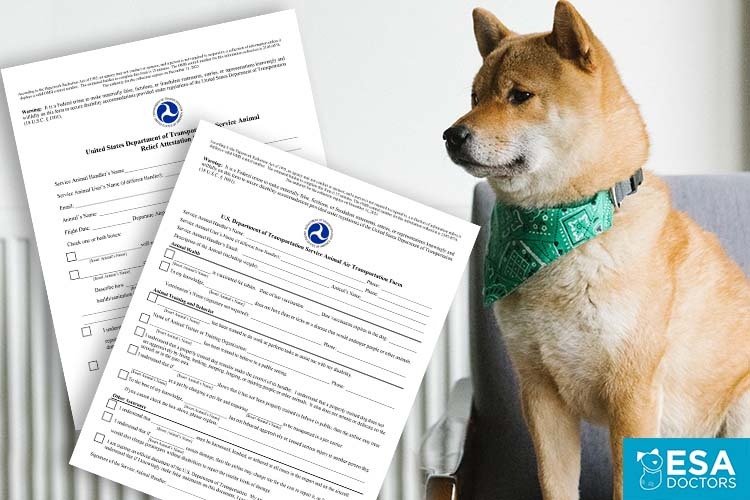
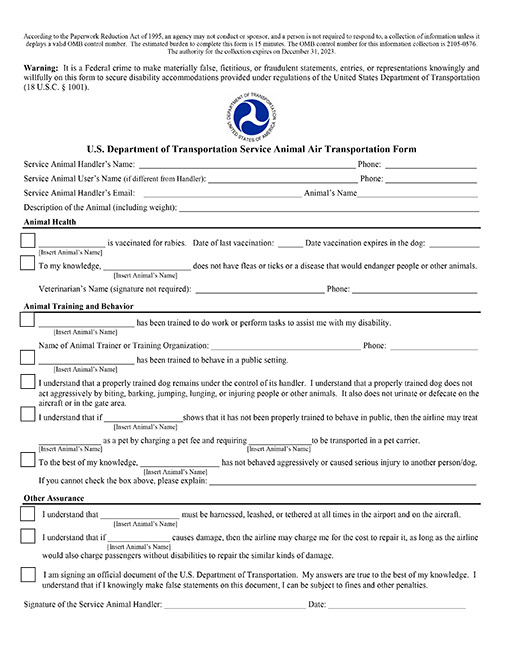
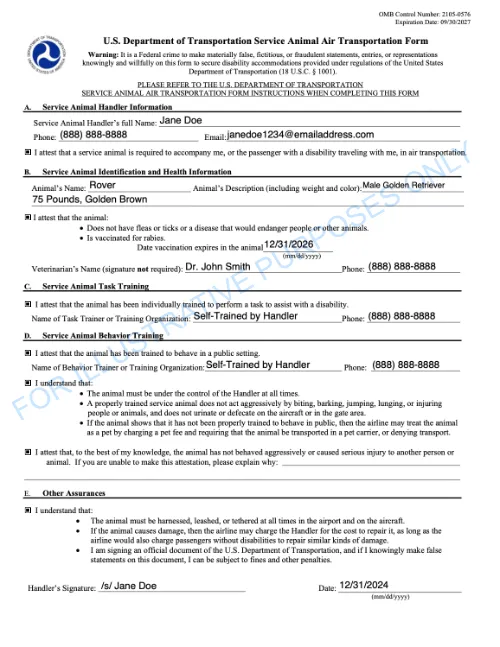
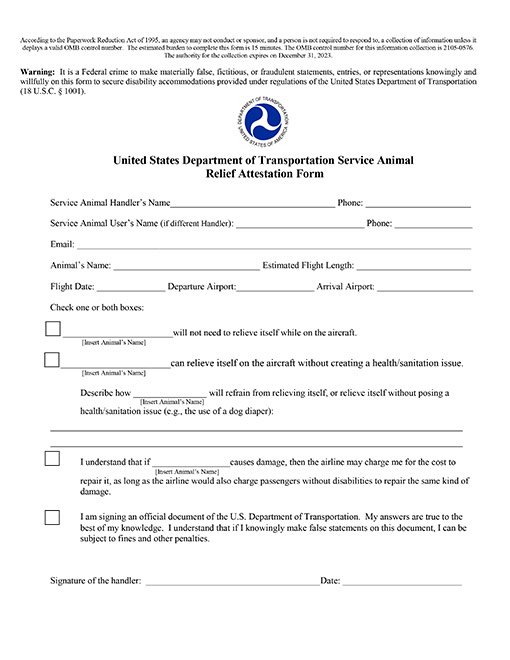

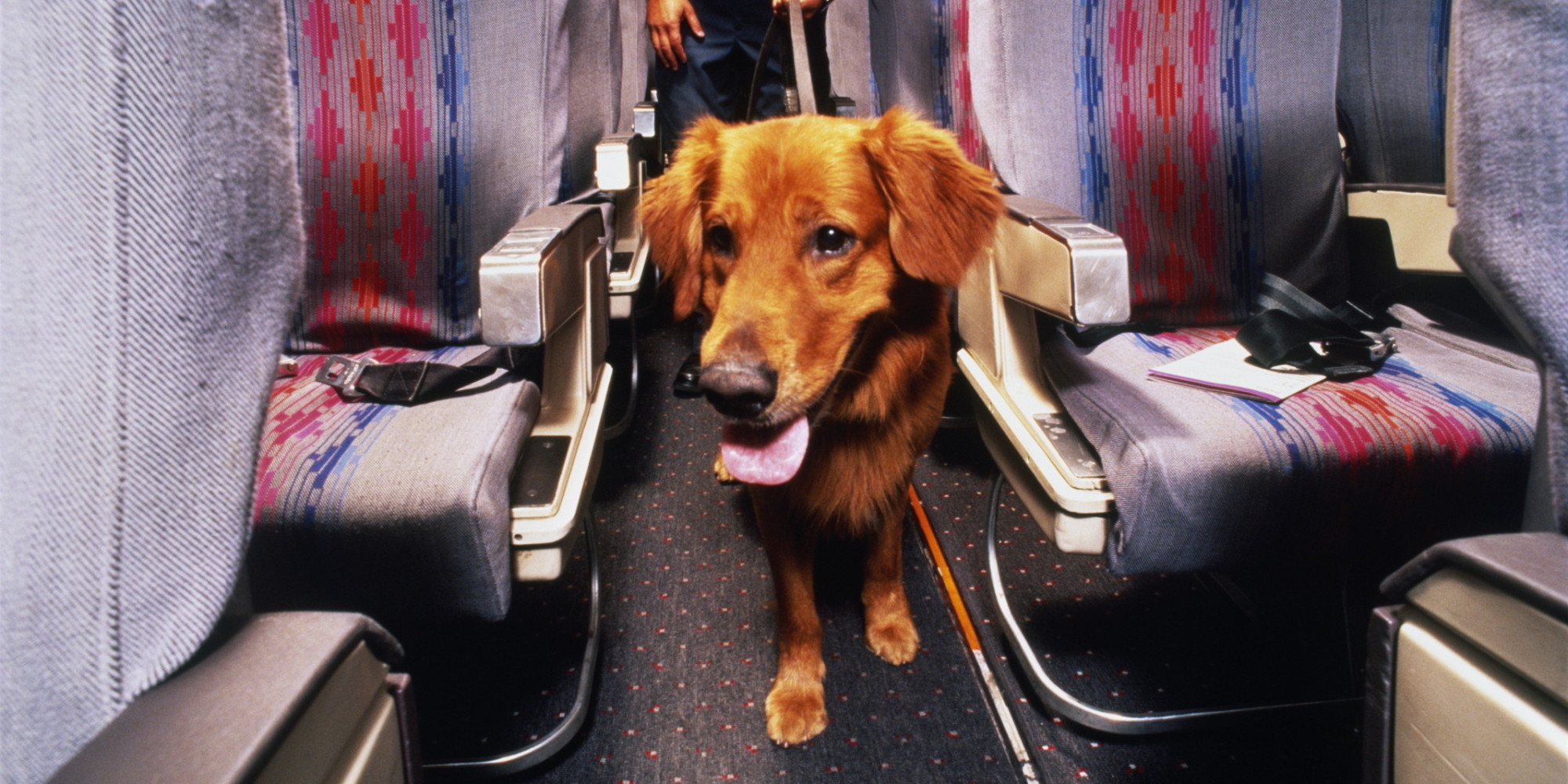
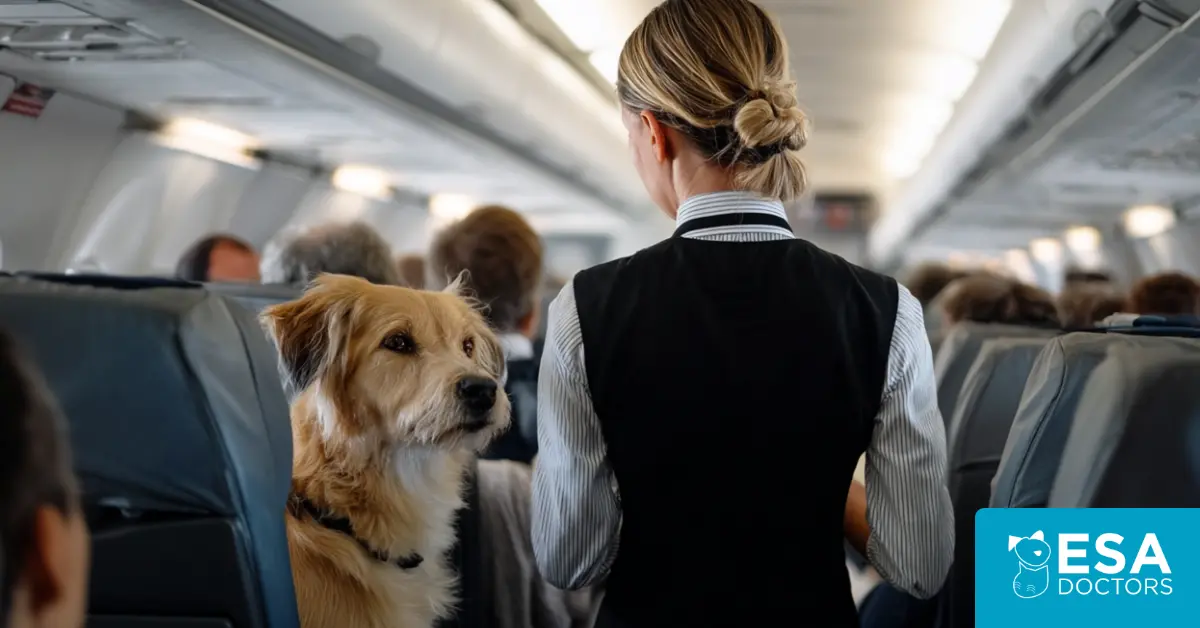
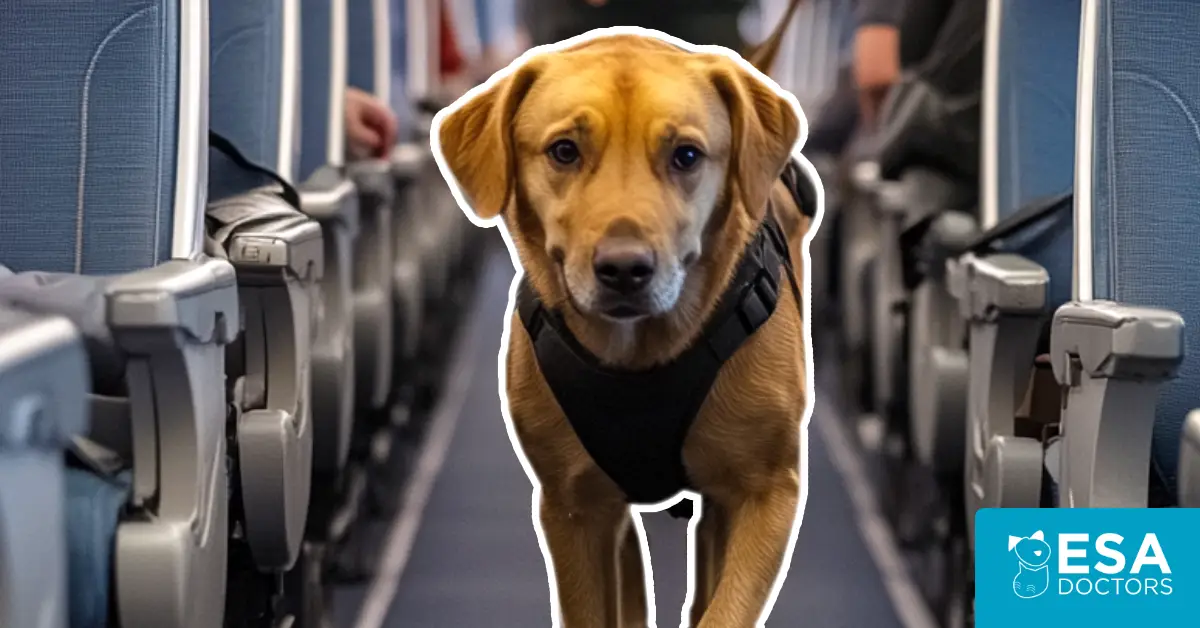
Please explain to me why I don’t need to show the psd letter or certificate
If you are flying with a service dog, the only document needed under the DOT’s rules is their Service Animal Air Transportation Form. The airline will not require you to share your PSD letter or a certificate. PSD letters are to document that you have a qualifying psychiatric disability under the ADA.
I have a trained therapy dog but now I’m needing to travel with her and I’m looking into getting her certified for that purpose. Once I have a letter from my doctor where can I get a legit service vest? Also do I need any other documents besides the DOT, PSD letter, and health records for my dog?
To fly with a service dog, the only document you need to submit to the airline is the DOT Service Animal Form. You don’t need to get any additional certifications or letters. For a guide on how to fly with a service dog, please see this article: https://esadoctors.com/how-to-fly-with-a-dog-travel-guide/
It appears the forms are now processed online, when I submitted the form for my flight it requested my flight confirmation # which covers all four legs of my trip to and from my destination but then it only asked for the flight information for the first leg of the flight.
Do I need to submit a separate request for each leg of the flight?
We recommend contacting the specific airline for clarification on this – each airline handles these requests a bit differently.
The author of this article apparently did not do his/her homework as he/she did not read the US DOT ruling. The DOT has not banned ESA’s. The DOT ruling indicates that airlines are not required to consider ESAs as service animals. They left the decision up to the individual airlines; essentially gave them the green light to exclude ESA from the service dog category.
The article states that the DOT “essentially” banned ESAs, since shortly after the new rules every U.S. airline ceased to recognize emotional support animals. In addition, ESAs were never categorized as a type of service dog – they have always been entirely separate categories of assistance animals with different requirements.
Hello,
Can you please provide a link where I can find something from DOT re:
“The DOT’s regulations made clear that you do not need a third-party trainer or organization to train your dog or certify that they have been fully trained.”
I want to see how they themselves address that you can put your own name as a dog trainer.
Thanks so much!!
The DOT carefully considered whether self-training for service dogs should be allowed and they determined it should. Many service dog owners train their own dogs and do not need the assistance of a professional trainer which can add considerable cost to the process of qualifying for a service dog. That is why you are allowed to list yourself as the trainer of a service dog. You can find the DOT’s rules at this link: https://www.transportation.gov/briefing-room/service-animal-final-rule
Do you need to fill out a form every year. How long is it good for?
It depends on the airline – some will keep your form on file, others will require you to submit a new form each time.
I am currently having the same problem with Allegiant. The ticket agent at the airport told me she saw on the screen that they denied my service dog because I trained him. She tried everything on the phone to convince them the dog was a service dog by his behavior at her counter for the 45 minutes she tried to convince them he was a real service dog. They would not respond to my emails with the DOT form which I submitted three times. I would get the computer generated, “we got your email” but that was it. I am taking further action by filing a DOT complaint against them. I had to pay the $50 and crate him. I don’t care about the money, but he can’t do his job in a crate. However, the money might be an issue for someone who doesn’t have it. I will never fly Allegiant again, even if the trip was free!!!
Anyone have issue with the date at the bottom of the form? SWA requires a new form filled out — with the exact date of travel only at the bottom.
Some airlines will keep the form on file for future travel. Unfortunately, others require that a new form be completed each time for travel.
Has anyone had problems with American Airlines accepting their DOT form with themselves being listed as the dogs trainer?
Our service dog was also rejected by Allegiant Airlines and we had to cancel our trip. They ask you to fill out the DOT form and send it in at least 48 hours before the flight. One of the questions on the form has to do with the name of the trainer and their phone number. If they cannot get in touch with the trainer…you will be denied. (Even if the training company went out of business during Covid, like ours did). This is a major issue for disabled travelers on Allegiant.
We’re very sorry to hear about the trouble you had.
Allegiant airlines is terrible I had a panic attack because they denied my service animal I paid so we could get on plane my panic attack got worse with out getting into detail the flight attendant was so kind and allowed me to take my service animal out of crate she seen my service animal jump on my chest for entire flight and calm me down the attendant agree she was a service animal I will not fly with allegiant airlines anymore it happened 3 times can anyone recommend a good airline I now have ptsd with airports
I am currently having the same problem with Allegiant. The ticket agent at the airport told me she saw on the screen that they denied my service dog because I trained him. She tried everything on the phone to convince them the dog was a service dog by his behavior at her counter for the 45 minutes she tried to convince them he was a real service dog. They would not respond to my emails with the DOT form which I submitted three times. I would get the computer generated, “we got your email” but that was it. I am taking further action by filing a DOT complaint against them. I had to pay the $50 and crate him. I don’t care about the money, but he can’t do his job in a crate. However, the money might be an issue for someone who doesn’t have it. I will never fly Allegiant again, even if the trip was free!!!